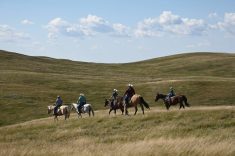Pigs were the first farm animal species we tried raising. We had pigs around 1995 when the price of hogs was up. Then the price of grain went up and the price of pigs went down. I’m sure you get the picture.
Since then we have discussed it many times. Partly because we have never enjoyed pork the same since, but mainly because I firmly believe their real worth on the farm lays not so much in meat production but in their ability to work up old fields.
Read Also

Harvest wraps up and fall work begins
At the Eppich famly ranch in western Saskatchewan, the fall harvest was successful with few breakdowns, cows and calves have been sorted and a new tractor has arrived
Our youngest son usually raises pastured poultry but this year decided to try his hand at raising a few weanlings. The idea was to keep one for us and market the rest for freezer pork. Our local provincially inspected plant is equipped to process pigs.
The first stage of the project was to access weanlings. There aren’t many small hog farmers anymore but we were successful. They arrived on the farm the end of April at about 50 pounds. We kept them in our empty henhouse for the first month. We lined it with puck board so the pigs couldn’t chew through the walls. From our earlier experience we knew they greatly enjoyed chewing wood. To minimize boredom we also gave them a basketball. That also minimized destruction. By the time they had discovered how to get their noses into the cracks in the floor their outdoor pen was ready and the weather was warm enough for them to be outside.
We decided to feed the pigs differently than we had in the past. Years ago we had them in a stationary pen and fed them chop. This time they were going to be in a portable pen (pig tractor) enabling them to dig and eat fresh greens. In the warm months we have an abundance of whey, buttermilk and skim milk, which is a favourite food of pigs. My son made porridge out of pea screenings, kitchen and garden scraps along with a vitamin/mineral supplement from the feed store. During canning season the pigs quite willingly ate all our scraps. We were rewarded for making them happy with amazing digging machines.
Porcine pasture renewal
We chose our goat and sheep pasture for our hog-rearing experiment. It was originally seeded in the 1960s so when just about nothing grew this year we really weren’t surprised. This ground was rootbound and compacted.
The first few weeks the pigs had to be on the same piece of ground for more than one day. Their pen was 10×20 feet and was built on old hydro poles for runners. Information from Manitoba Agriculture advised it would take seven pigs per acre to overturn all of the pasture in a season but our portable pen was only big enough for four animals.
An acre is 43,560 square feet. The pen is 200 square feet. So, we calculated we would have to move the pen 218 times to turn over an acre. What we didn’t expect was that four pigs once they hit about 100 pounds would need to be moved more than once a day. This was a wonderful surprise because that meant we might actually succeed in turning over an acre between May 1 and first snow. The other thing we found is that pigs are more than happy to dig out large rocks.
To entice them to dig out the boulders my son would pour extra water around it to get the ground soft. Then he would let the pigs go to work. Within about 24 hours they would have the rock loosened enough that he could easily pop them out with the loader and tractor.
The design of the “pig tractor” needs to be tweaked a bit for next year to enable better turning. Another point we missed was that we started at the near end of the pasture instead of the furthest point. So, the animals might not want to pass over the newly seeded area to get to the rest of the pasture next spring. Next year we will start at the far end where we winter feed cows and let the pigs turn over all that ground for us. Not only are they extremely good at it they seem to enjoy it. When they hear my son coming with their slop they make the happiest pig noises we have ever heard.
This experiment has been a success so far. What was unexpected was how watching a creature live its life just as it was intended could be so heartwarming. We plan to spread rotted manure on the area worked over this year and continue the pasture-rearing program from where they left off. We look forward to enjoying pork this winter, as well as the added growth to our pasture next summer. †














